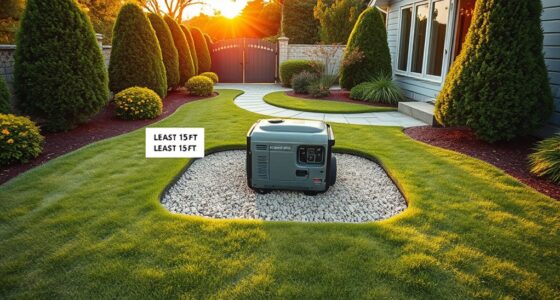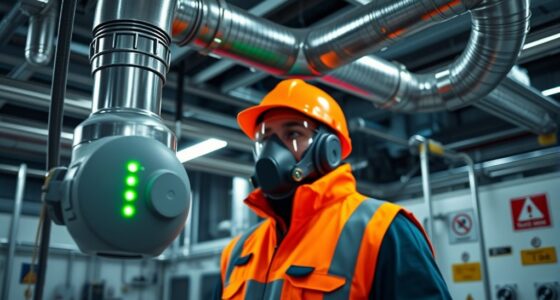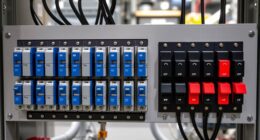To guarantee safe generator placement, check local regulations and obtain necessary permits. Position your generator away from windows, doors, vents, and combustible materials, keeping at least 10 feet from property lines and residential windows. Elevate it on stable ground and protect it from weather while maintaining proper clearances for exhaust and air intake. Following these guidelines improves safety, efficiency, and longevity. Keep exploring for more essential tips to optimize your setup and stay compliant.
Key Takeaways
- Verify local zoning laws, permits, and setbacks before installing a generator.
- Place the generator away from windows, vents, and combustible materials for safety.
- Maintain minimum distances: 10 feet from property lines and 10 feet from windows.
- Elevate on stable, flat ground to prevent flooding and facilitate maintenance.
- Ensure proper clearance from air intake/exhaust outlets to avoid hazards and improve efficiency.
Understanding Local Regulations and Building Codes

Understanding local regulations and building codes is vital before installing a generator. You need to check for zoning restrictions that may limit where you can place your unit. Some areas have specific setbacks or designated zones for generators, and ignoring these rules could lead to fines or forced relocations. Permit requirements are also indispensable; many jurisdictions require you to obtain a permit before installation. Failing to do so can result in penalties or the need to remove and reinstall the generator. Review local ordinances and consult with authorities to ensure compliance. Knowing these regulations helps you avoid legal issues and guarantees your generator setup is safe and lawful. Always prioritize understanding these requirements before moving forward. Additionally, understanding building codes ensures your installation meets safety standards and reduces the risk of hazards.
Optimal Placement Strategies for Safety and Efficiency

Choosing the right spot for your generator is essential for both safety and efficiency. You should place it away from windows, doors, and vents to minimize noise mitigation issues, ensuring it doesn’t disturb your household or neighbors. Protect your generator from weather elements by locating it under a canopy or in a sheltered area, reducing exposure to rain, snow, or excessive sun. Elevate it on a flat surface to prevent flooding and ensure proper ventilation. Keep it positioned on stable ground to avoid vibrations and potential damage. Proper placement not only enhances safety but also improves overall operation, making maintenance easier and extending the generator’s lifespan. Additionally, considering site-specific hazards can help prevent accidents related to environmental risks. By considering noise mitigation and weather protection, you optimize your generator’s performance and safety.
Essential Clearance and Distance Requirements

Maintaining the proper clearance and distance around your generator is essential for safe operation and easy maintenance. Adequate space helps prevent fire hazards, reduces noise, and improves fuel efficiency by ensuring proper airflow. Follow setback guidelines to keep your generator at a safe distance from structures and vents. Use the table below to understand the necessary clearances:
| Clearance Area | Minimum Distance |
|---|---|
| Combustible materials | 5 feet |
| Residential windows | 10 feet |
| Air intake/exhaust | 3 feet |
| Property line | 10 feet |
Proper setbacks optimize noise reduction and fuel efficiency, making your generator safer and more effective. Remember, maintaining these clearances is key to long-term performance. Additionally, considering diverse designs for your generator setup can enhance safety and aesthetics around your property.
Frequently Asked Questions
What Are the Common Penalties for Non-Compliance?
If you ignore generator regulations and setback enforcement, you could face fines, penalties, or even legal action. Authorities prioritize safety and compliance, so non-compliance risks property damage, injuries, or fire hazards. Penalties vary by jurisdiction but often include hefty fines or mandates to relocate or modify your generator. Staying within setback requirements guarantees safety and avoids costly penalties, helping you operate your generator responsibly and in accordance with local laws.
How Often Should I Inspect My Generator’s Placement?
You should inspect your generator’s placement at least once every three to six months. Make sure the generator maintains proper clearance and setback regulations to ensure safety and efficiency. Regular inspections help identify potential issues like obstructions or improper setbacks that could cause hazards. Keep an eye on ventilation, fuel lines, and nearby structures, and adjust the placement if needed to stay compliant with local setback regulations and safety standards.
Can Multiple Setbacks Be Combined for Larger Generators?
Yes, multiple setbacks can be combined for larger generator configurations, but you should prioritize setback optimization. Confirm that the combined setbacks meet local codes and safety requirements. Proper placement minimizes risks, so consider how each setback contributes to safety and accessibility. Always consult with a professional to determine the best configuration, as combining setbacks might affect ventilation, noise, and fire safety, especially for larger generators.
Are There Specific Safety Signs Required Around Generators?
You should always keep safety in mind when around generators—no cutting corners. Proper generator signage is essential to warn others of potential hazards, while safety barriers help keep people at a safe distance. These signs and barriers act like a shield, preventing accidents and ensuring everyone stays safe. Make sure to follow local regulations for specific signage requirements, and regularly check that barriers and signs are clearly visible and in good condition.
How Do Weather Conditions Affect Setback Requirements?
Weather impact can substantially influence setback adjustments for your generator. In high winds, heavy snow, or rain, you should increase setbacks to prevent damage or safety hazards. Cold temperatures might require relocating or protecting your unit, while storms can cause shifting ground. Always monitor weather forecasts and consult local codes to guarantee setbacks are adequate for changing conditions, keeping your generator safe and compliant during adverse weather.
Conclusion
By following these guidelines, you’ll keep your generator operating smoothly and safely—think of it as planting a sturdy tree that won’t fall in a storm. Understanding local codes, choosing the right spot, and maintaining proper clearances are your roots for success. When you prioritize safety first, you create a reliable power source that stands tall through any storm. Stay vigilant, stay safe, and let your generator be a beacon of dependable energy.









